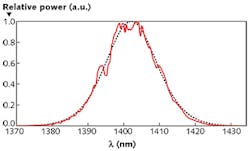Mid-IR femtosecond fiber laser has high-peak-power pulses
A group at Centre d'Optique, Photonique et Laser (COPL), Université Laval (Québec, QC, Canada) has reported a mid-IR femtosecond fiber laser, a device emitting at a 2.8 μm wavelength. This extends the range of femtosecond fiber lasers into the molecular fingerprint region, making these lasers valuable for ultrafast science in this range. The laser is based on erbium-doped fluoride glass fiber.
A ring cavity is formed of 3 m of double-clad fiber fabricated by fluoride glass experts Le Verre Fluoré (Bruz, France), with bulk optics forming part of the cavity. The fiber itself has a 15-μm-diameter core, a numerical aperture (NA) of 0.12, and a cladding diameter of 260 μm. Surrounding the cladding is a polymer with a lower refractive index that allows cladding pumping. The fiber is pumped at 976 nm with a 7 W multimode laser diode, with the pump light coupled into one end of the fiber by a dichroic mirror and absorbed at the other end by a cladding mode stripper. Aspheric zinc selenide (ZnSe) lenses couple light into and out of both ends of the fiber. The result is a mode-locked train of pulses, with a full-width half-maximum (FWHM) duration of 207 fs, a repetition rate of 55.2 MHz, and a peak power of 3.5 kW. Because the fiber is operated in the anomalous dispersion regime, the pulses take the form of stable solitons whose near-ideal shape are seen by examining the second-harmonic light pulse generated by focusing the laser light through a beta barium borate (BBB) crystal. Reference: Simon Duval et al., Optica (2015); http://dx.doi.org/10.1364/optica.2.000623.
About the Author
John Wallace
Senior Technical Editor (1998-2022)
John Wallace was with Laser Focus World for nearly 25 years, retiring in late June 2022. He obtained a bachelor's degree in mechanical engineering and physics at Rutgers University and a master's in optical engineering at the University of Rochester. Before becoming an editor, John worked as an engineer at RCA, Exxon, Eastman Kodak, and GCA Corporation.

